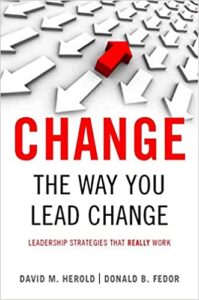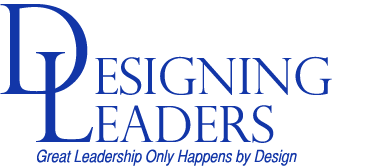Book Review: Change the Way You Lead Change
I always get a little nervous when a book’s title includes words in boldface, all capital letters, or underlined multiple times. It seems like someone is yelling across a room to get my attention, hoping to convince me of something by sheer volume and decibels rather than by reasoning and content. So it was with a little trepidation that opened Change the Way You Lead Change: What You Really Need to Know About Leading Change.
 As it turns out, though, authors David Herold and Donald Fedor really have identified some of the key questions that should be asked before undertaking a serious organizational change effort. These questions, if asked and answered by change leaders, can put the brakes on kneejerk reactions and lead to a more reasoned change effort that will be right for the company’s circumstances and be more acceptable to the employees who have to implement it. While the concepts themselves are not particularly earth-shattering, they break down the simple questions of “who, what, when, where, how?” into chapter-length discussions on who the leader is and what skills they bring, the composition of the workforce, the circumstances that seem to be demanding change, realism vs. idealism, and other considerations that will give the potential change leader pause. The purpose is not to stop you from creating change by causing you to question your whole reason for being, but merely to slow you down and make you think more clearly about what is most likely to be effective.
As it turns out, though, authors David Herold and Donald Fedor really have identified some of the key questions that should be asked before undertaking a serious organizational change effort. These questions, if asked and answered by change leaders, can put the brakes on kneejerk reactions and lead to a more reasoned change effort that will be right for the company’s circumstances and be more acceptable to the employees who have to implement it. While the concepts themselves are not particularly earth-shattering, they break down the simple questions of “who, what, when, where, how?” into chapter-length discussions on who the leader is and what skills they bring, the composition of the workforce, the circumstances that seem to be demanding change, realism vs. idealism, and other considerations that will give the potential change leader pause. The purpose is not to stop you from creating change by causing you to question your whole reason for being, but merely to slow you down and make you think more clearly about what is most likely to be effective.
The authors provide plenty of examples of CEOs trying to change their corporate cultures as well as outsiders being brought in to save the day. While this will advance your understanding of what they mean, by putting concepts into practical terms, the facts and discussions seem to come largely from media reports and some individual interviews. If you are looking for a rigorous academic study underlying their conclusions, this probably is not going to do it for you.
In fact, it is these examples that make me question the usefulness of this book for leaders in small companies or at the lower levels of management. The focus here seems to be on CEOs, specifically CEOs of major corporations, and manufacturing firms in particular. While the basic concepts are useful to leaders at all levels, especially those who aspire to become CEOs of big firms someday, I am not sure how relevant the majority of this book will seem to those outside a fairly narrow niche. You are liable to read this and say “well, I’m not the CEO of Hewlett-Packard, so this does not apply to me,” and in the process, you might miss the stuff that actually IS applicable. Another book, more specifically aimed at smaller businesses, might be a better choice. My suggestion: try looking for this at a library before looking at a bookstore.
Change leadership is only one element of the broader concept of leadership, but it’s also one of the most challenging. There are so many variables associated with organizational change that it’s imperative for change leaders to be asking the right questions. The questions presented here sound like the right ones, even if the book itself may not be.
- Posted by
 Designing Leaders
Designing Leaders - Posted in Book Reviews
 Nov, 27, 2015
Nov, 27, 2015 Comments Off on Book Review: Change the Way You Lead Change
Comments Off on Book Review: Change the Way You Lead Change
Categories
- Book Reviews
- Change
- Communication
- COVID-19
- Creativity & Innovation
- Culture
- Diversity & Inclusion
- Employee Development
- Ethics
- Free Agents
- Health and Balance
- Leader Development
- Leading
- Management
- New Leaders
- Planning
- Recruiting and Retention
- Uncategorized
Archives
- August 2020
- July 2020
- June 2020
- October 2019
- September 2019
- August 2019
- July 2019
- June 2019
- May 2019
- March 2019
- February 2019
- January 2019
- December 2018
- November 2018
- October 2018
- September 2018
- August 2018
- July 2018
- June 2018
- May 2018
- April 2018
- March 2018
- February 2018
- January 2018
- December 2017
- November 2017
- October 2017
- September 2017
- August 2017
- July 2017
- June 2017
- May 2017
- April 2017
- March 2017
- February 2017
- January 2017
- December 2016
- November 2016
- October 2016
- September 2016
- August 2016
- July 2016
- June 2016
- May 2016
- April 2016
- March 2016
- February 2016
- January 2016
- December 2015
- November 2015
- October 2015
- September 2015
- August 2015
- July 2015
- June 2015
- May 2015
- April 2015
- March 2015
- February 2015
- January 2015
- December 2014
- November 2014
- October 2014


 Nov, 27, 2015
Nov, 27, 2015